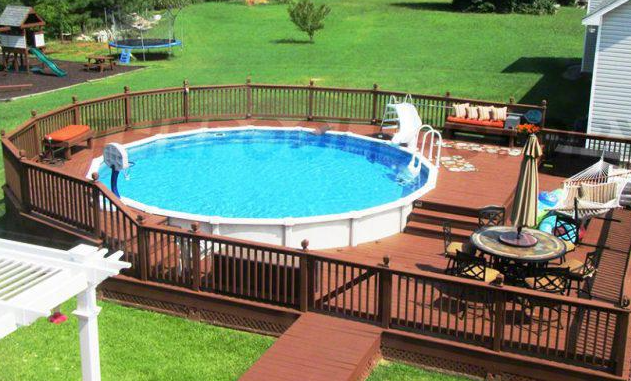 Pools are well known for being rough on the surrounding material. Pool decks are often thoroughly wet on a daily basis and are often exposed to chemicals used to protect the water in the pool. In the decking that you select, the ability to withstand these and other aspects of the pool environment is important.
Pools are well known for being rough on the surrounding material. Pool decks are often thoroughly wet on a daily basis and are often exposed to chemicals used to protect the water in the pool. In the decking that you select, the ability to withstand these and other aspects of the pool environment is important.As well as cracks and frost heaves during freeze/thaw cycles, both concrete and natural stone are subject to problems such as etching of the finish. This implies that every few years you're likely to need to fix or rebuild the patio of your pool to help preserve its functionality and beauty.
Pools come in all shapes and sizes, but your pool deck has to adapt to the pool itself, not just your yard or garden. When shaping them into distinctive lines of modern pools, items like concrete and pavers become hard and costly to cut and form. To ensure that they work well for a long time, they also need a lot of leveling, drainage and layering of setting materials.
These days, sustainability is a significant factor in every construction material. It's important to look at how it will affect not only the environment, but also the area surrounding its installation, no matter what you're constructing. Another sustainable aspect is that sustainable goods concentrate on longevity so they can outlast other substitutes and do not need regular replacement.
Although a natural material is stone pavers, they are far from sustainable. If the quarries are finished, new stone can not be manufactured, rendering stone a non-renewable source. Most of the stone is often quarried long distances from where it is placed, often outside the world, and must be transported at substantial cost; thus making the carbon footprint of stones very high.
You are also not only bringing in a flooring material when you are constructing a pool deck; you might even be building some other areas and accessories. Privacy walls, pool sheds, changing rooms, pergolas, shade overhangs and outdoor seating are also installed close to a pool to increase the area's enjoyment.
Many pools are used while the sun is beating down on the surface of both the pool and the deck during the hottest months of the year. Materials such as stone and concrete will also hold on to heat as you walk to and from the pool, getting hot and uncomfortable underfoot. When wet, these materials can also become very slippery, which is not recommended for pool decks and patios because it poses a serious risk of dropping. The course and abrasive surface just aggravate the problems arising from falling and losing one's footing.
It is necessary to bear in mind that for use on a pool deck, not all wood is suitable. To help protect it from the humidity of the pool, pressure treated wood needs staining or sealing on a regular basis. During the lifespan of your deck, this makes the material less sustainable and much more expensive.

